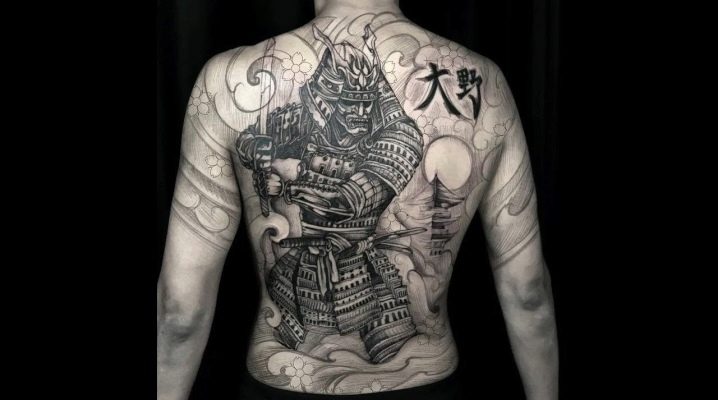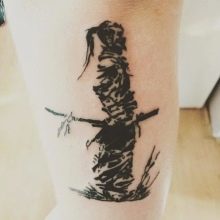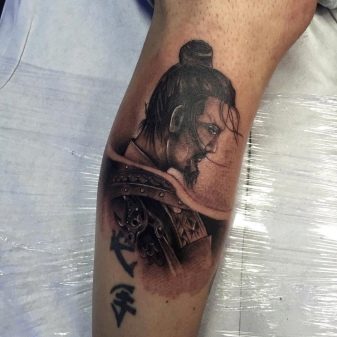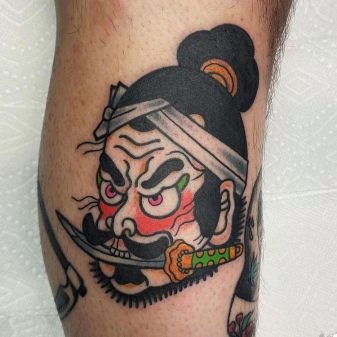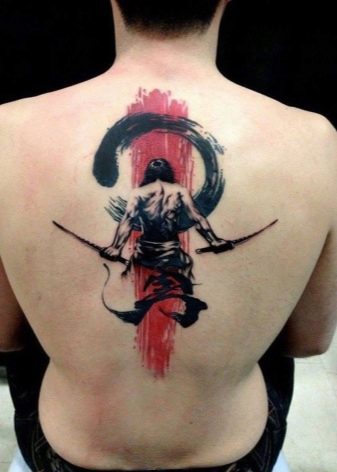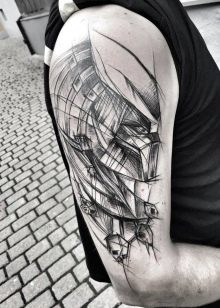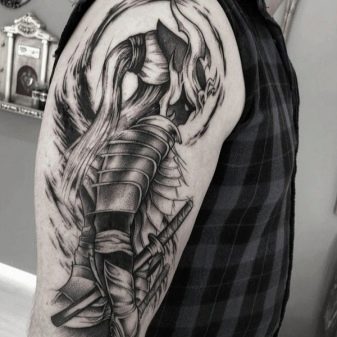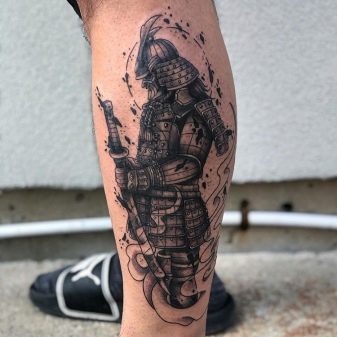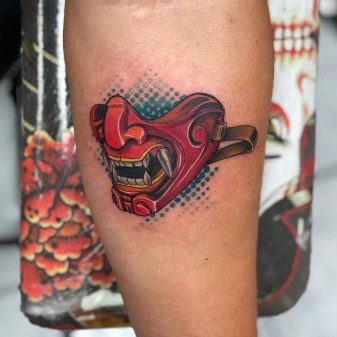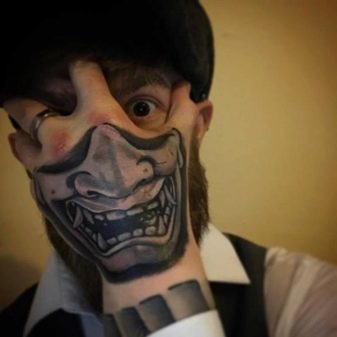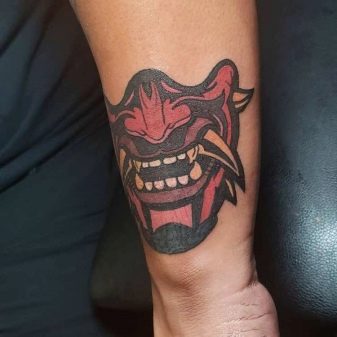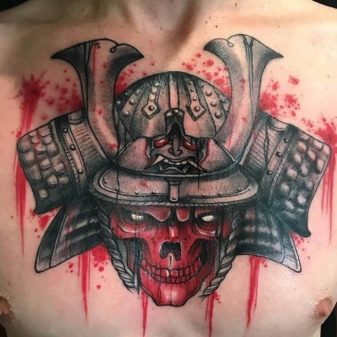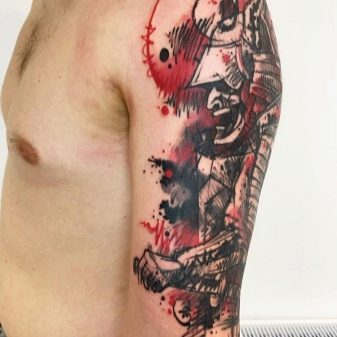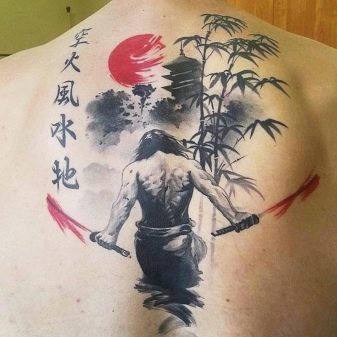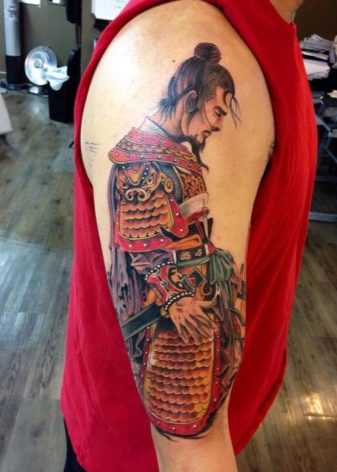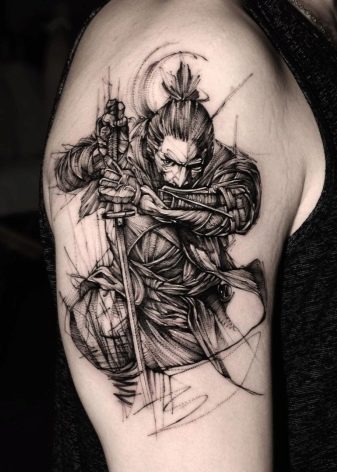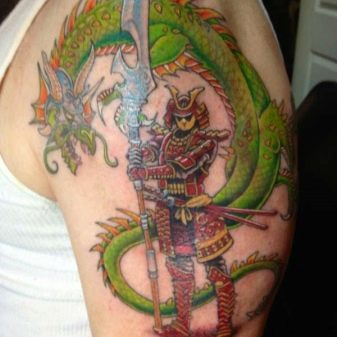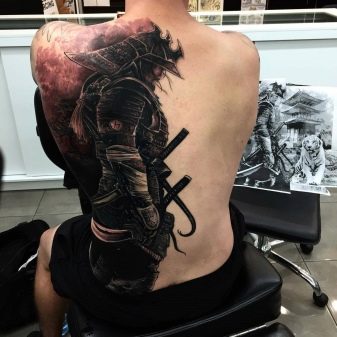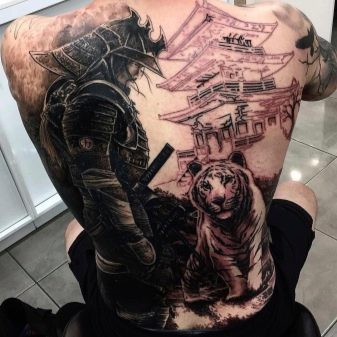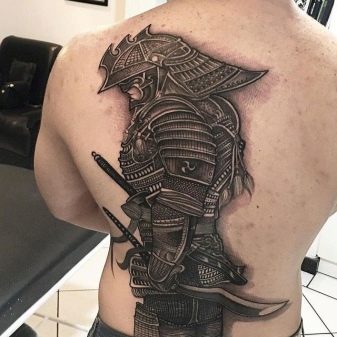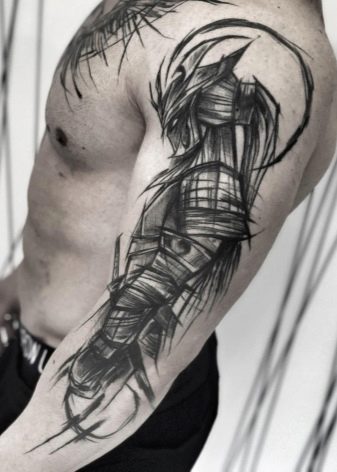The meaning of tattoo for men in the form of samurai and their placement
Men's tattoos depicting a samurai are among the most mysterious. In the article we will tell you what they mean, what they are and where it is better to place them.
Features and meaning
The image of the Japanese warrior carries a special philosophy. It is associated with a code of honor and a specific life position, following the military path.
The samurai class was formed in the 7th century and ceased to exist in the 20th. The military class was respected and respected. The symbolic meaning of tattoos is associated with the principles of samurai life.
The owner of the tattoo is in solidarity with the postulates, he has the same views. He is fair, fearless, honest and truthful. Honors traditions, respects elders, has his own dignity, is ready for self-sacrifice.
Those who choose such tattoos are constantly improving physically. For them, strength of mind, courage and resilience are important, despite the difficulties they face in life.
This is a symbol of life's struggle, such tattoos are chosen by men who are distinguished by discipline and inner strength. A samurai on a male body personifies the generosity and wisdom of a person.
In Japan, these samurai tattoos are applied with Irezumi using bamboo equipment with metal needles.
The technique is quite painful, therefore it is not suitable for people with a low pain threshold.
Styles and colors
Samurai-themed tattoos are monochrome and color. Colored pigments are most in demand - red, yellow, blue and their combination.
These paints work well with traditional old school techniques. For example, they are basic old-school style with an inherent black outline for each element.
The colors of the style are quite bright and catchy. Usually, one color is the leading color, the rest only complement the overall picture. The same colors are used in Japanese tattoo art.
In this case, the basis of the tattoo is black pigment. Against this background, colorful interweaving patterns are created, united by a common idea.
A combination of black and red pigments is in fashion. The main plot is drawn in black ink. Reds add a negative coloring to the drawing, associated with the bloody path of a warrior.
For example, the bloody sun behind the samurai's back, flying leaves, splashes of blood on his sword and armor are created in red. Sometimes a barely noticeable red tint is emphasized by the details of samurai armor or the bloody shadow of a warrior.
Often in the sketch there are red spots - elements of an abstract style. Made in color, they perfectly combine with the basic technique taken as the basis of the sketch.
Monochrome options are perfectly conveyed in such stylistic directions as blackwork, realism, graphics, sketch style. Each of them has a number of its own characteristics.
In this case, the warrior can be portrayed in a traditional and realistic manner. It can be flat and voluminous, laconic and complexly drawn.
For example, in the blackwork technique, the samurai seems to appear from the black background, which abounds in the tattoo. A realistic warrior, made in black and white, looks especially mesmerizing.
The graphic samurai is unrealistic, but proportioned. It has no shadows and no feathering. All contours and volume are defined by strokes and lines. Dilution of the paint used is not allowed.
Sketch style is a fashionable trend in the world of tattoo, ideal for conveying samurai themes. The style is somewhat harsh, his drawings resemble undrawn pencil sketches.
Trash polka is an extraordinary style for this theme. The embodiment of the samurai in the technique of combining the incongruous looks very impressive.
The basic principle is the decoration of death, although the negative message does not change from this.
Views and sketches
Samurai tattoos differ in the completeness of the picture, plot, detail, manner of execution. This can be an image of a warrior, individual items of samurai armor.
Each sketch is unique and self-sufficient, regardless of the color and technique of body art. One of the popular images is the samurai mengu mask. She is a talisman against ill-wishers and has a different shape.
Performed in a fearsome manner, it is a key piece of a warrior's armor. It is supplemented with various elements inherent in resources of specific styles (for example, colors, skulls).
It can resemble a human grimace or be performed in the form of a baring demonic beast. The samurai only used it in combat.
Mengu is usually drawn in an oriental manner with elements of a dragon's muzzle (wide nose, swollen nostrils, large fangs). The meaning of such an image lies in the fact that a person has embarked on the path of a warrior and is ready for any trials.
A frequent choice of clients of tattoo parlors is the kabuto samurai helmet, which serves as the protection of a warrior. He has high horns, a massive upper part. Often such a warrior supplemented his protection with powerful armor.
The warrior is depicted with a sword and firearms. All types of tattoos speak of masculinity, a formidable character, behind which a strong personality is hidden.
Intimidating samurai tattoos in full gear are found in the thrash polka style. It is here that a combination of red and black pigments is most often used.
The idea of a tattoo can be a samurai weapon, metal or leather chain mail. The image of the warrior himself is often complemented by bamboo trees, sakura branches and petals, mountains and rivers.
Each addition has its own meaning. Bamboo means longevity, striving upward. Sakura - the transience of life. Mountains are an ambiguous symbol, a sign of reflection of the world order.
In addition to pools of blood and flower petals, samurai are sometimes painted against the background of fanz and arbors. The warriors themselves can be either in full combat uniforms or in a kimono, without a helmet and mask, sometimes in a characteristic straw hat.
Often the hair of a samurai is gathered in a bun and disheveled. He is always calm and confident. He is portrayed as a proud loner, a young and mature man.
The type of warrior determines the character traits
The warrior can be portrayed as pensive, calmly standing against the background of the moon or sun. In other sketches, he attacks, wages a fierce struggle, drawing his sword.
In the eastern technique, a warrior is depicted with a dragon, symbolizing wisdom and heavenly blessings. The manner of performance does not pursue the goal of realism. However, it is quite picturesque.
Where can you post?
The placement of a tattoo depicting a samurai depends on the size of the drawing, the anatomy of the body of a particular client, the amount of work, the artistic skills of the master.
In the sleeve technique, it is positioned from the shoulder to the wrist, completely covering the arm. In this case, the samurai himself is usually one of the elements of the overall sleeve pattern. This technique is usually used in oriental tattoos.
The costume technique involves covering most of the body. For the Japanese, this is up to 70%, but in our country, men rarely apply tattoos simultaneously on their backs, arms, lower back, and thighs.
Most often, three-dimensional images adorn the entire surface of a physically developed male back. Here the masters fill in voluminous works, often placing the main character in the center of the composition.
The back is the best place for large to medium sized male tattoos. Even with aging, the pattern applied here will not sag and fade as quickly as it does elsewhere.
In addition, the position on the back will never get bored or annoying after some time after application. When determining the place, they proceed from considerations of openness: not everyone likes open tattoos, they often contradict the dress code.
Aside from the center tattoos, the sketch on the back can be positioned on one side, grabbing the shoulder blade and extending from the neck to the thigh. In this case, the tattoo can go to the arm up to the elbow.
Great places to display a samurai on your arm are the shoulder and forearm. Both small subject and plot tattoos are clearly visible here. Small tattoos are stuffed on the fist.
An extraordinary solution is to place a tattoo covering several zones: arms to the elbow, forearm, sternum, shoulder blade and side to thigh. With this arrangement, the warrior is usually stuffed on the arm, and additional elements extend to other parts of the body.
Sketch tattoos are applied in different places. Apart from the arm and sternum, these tattoos look great on the leg. However, the size of the images may vary.
The location may depend on the pain of the procedure. For example, transferring an image under the skin of the hand is less painful. There are many soft tissues, few nerve endings.
The pattern located near the spinal column, on the contrary, will be painfully stuffed, as well as on the neck, sides, chest.
